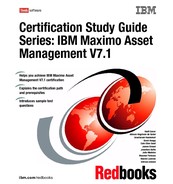206 Certification Study Guide Series: IBM Maximo Asset Management V7.1 memory utilization, the server process suffers from Java garbage collection pauses because of large heap space, and slow performance. 10.12.3 Performance and system maintenance guidelines The following considerations are related to system maintenance: Define a fixed maintenance window to perform routine maintenance on your deployment. Inform your users of the maintenance schedule by using the Bulletin Board within IBM Maximo Asset Management. Perform load- balancing tasks on your servers and reassess your thread counts and your socket and memory settings in your application deployment on a regular basis. Consult the WebSphere Application Server and WebLogic Server documentation for further information. Adjust thread counts to improve performance. Application servers use threads to listen for and process requests from the browser. A thread represents a work item or task. Application servers ( WebSphere Application Server and BEA WebLogic Server) have default settings for number of threads. WebSphere Application Server has a default minimum thread size of five. A WebLogic Server has a default thread count of 25 ( when started in production mode). You can, and often should, revise these values to improve system performance. To optimize performance, try to determine the correct number of threads. If the thread count is too high, you have too many simultaneous requests on the processor level, and servicing the requests becomes inefficient. If the thread count is too low, the processor is not fully utilized. The queue grows and the workload accumulates. The correct number of threads varies from site to site, but an optimal number of threads can often be found in the range of 40 - 55. The number depends on the volume of front- end transactions ( user load) and back- end transactions ( nonuser load). Use the WebSphere Application Server and WebLogic Server monitoring features to set and monitor thread usage and queue times for your application servers. To buffer database growth and performance, implement indexes to speed up search requests within common used modules, for example, Purchasing and Work Order Tracking modules. A database administrator can monitor growth and sizing and tune the database accordingly. Frequently consult IBM Asset Management user groups and knowledge bases for issues and tips about tuning, performance, and best practices. Conduct regular audits and database integrity checks to find any backend database malpractices or possible bugs and errors.
